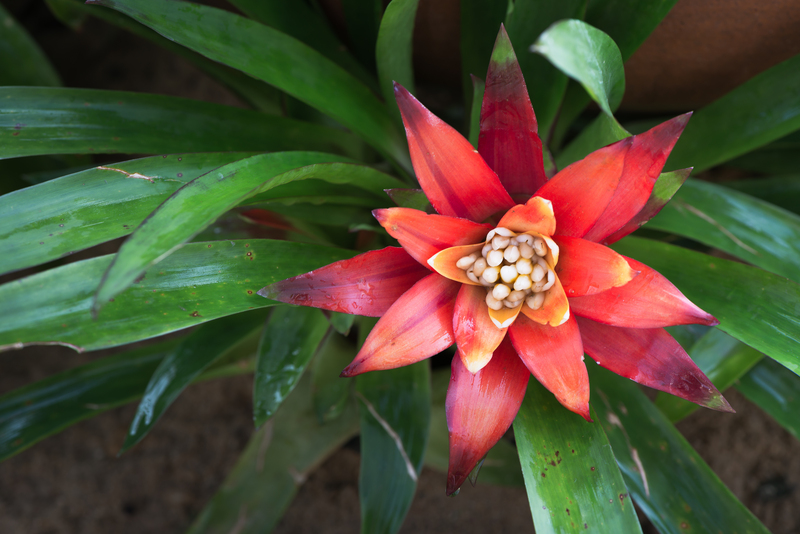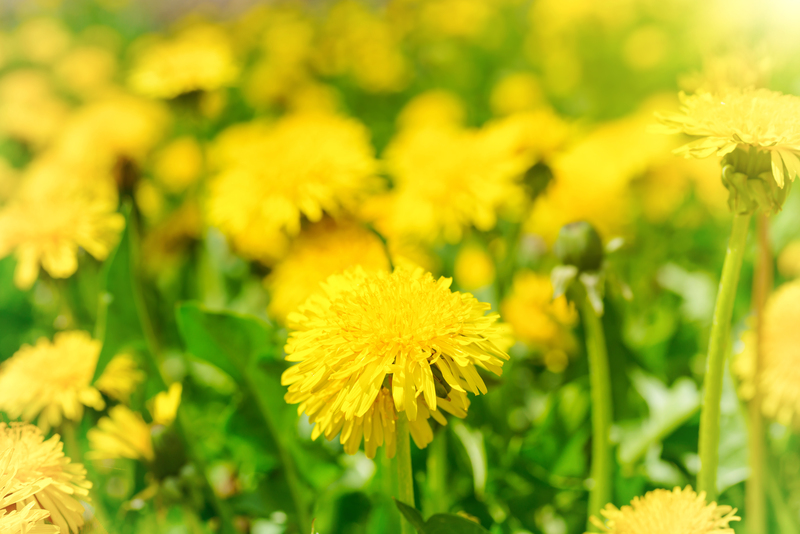Essential Tips for Successful Container Gardening
Posted on 27/08/2025
Essential Tips for Successful Container Gardening
Are you looking for a simple yet rewarding way to green your living space? Container gardening is an excellent solution for beginners and seasoned gardeners alike. Whether you have a sprawling backyard, a petite patio, or just a sunny windowsill, you can enjoy a lush, productive container garden. This comprehensive guide covers the best practices for successful container gardening--from plant selection and soil to watering, fertilizing, and troubleshooting.

Why Choose Container Gardening?
Container gardening offers unparalleled flexibility and accessibility. If you have limited space, poor soil, or mobility challenges, container gardening makes it easy to create a thriving green oasis almost anywhere. Urban dwellers can cultivate vibrant vegetables and blooms on balconies, while homeowners can accent their porches or patios. Indoor containers brighten up rooms and purify the air.
- Space Efficiency: Ideal for small yards, balconies, terraces, or windowsills.
- Mobility: Move your plants to chase the sun or protect them from harsh weather.
- Pest and Disease Control: Isolating plants helps limit pests and soil-borne diseases.
- Creative Design: Use diverse containers and plant varieties for endless visual possibilities.
Choosing the Right Containers
Container selection is the foundation for a productive container garden. The shape, size, and material of your containers matter greatly for plant health and ease of maintenance.
Size Matters
Plants need room for root development. Small pots dry out faster and hinder growth, while oversized containers may retain too much moisture. As a rule of thumb:
- Herbs, lettuces, and small flowers: 6-8 inches deep x 6-10 inches wide
- Tomatoes, peppers, eggplants: 12-18 inches deep x 12-24 inches wide
- Dwarf fruit trees, large shrubs: at least 18+ inches deep x 18+ inches wide
Container Materials
- Terracotta: Classic, attractive, but dries out quickly; ideal for Mediterranean herbs.
- Plastic: Lightweight, affordable, retains moisture longer, available in various colors.
- Wood: Natural appearance, insulates roots, but can rot--use treated or rot-resistant wood.
- Metal: Modern look, durable, but can heat up rapidly in direct sun.
- Fabric Grow Bags: Allow air pruning, lightweight, great for potatoes and root crops.
Drainage is critical--ensure all containers have sufficient drainage holes. You can add a layer of gravel or broken pottery at the bottom to aid water flow.
Selecting the Best Soil Mix
Unlike garden beds, container plants rely exclusively on the soil within their pots. For successful container gardening, use a high-quality potting mix--never ordinary garden soil, which can compact and restrict roots.
- Choose a lightweight, sterile, soilless mix: Look for combinations of peat moss (or coconut coir), perlite, vermiculite, or composted bark.
- Enrich with organic matter: A handful of compost or well-rotted manure improves fertility and water retention.
- Moisture control: Some commercial potting mixes include moisture-retaining crystals--useful in hot or dry climates.
- pH: Most vegetables and flowers thrive in a slightly acidic to neutral mix (pH 6.0-7.0).
Picking Plants for Container Success
Not all plants are ideal for pots, but with thoughtful selection, you can grow virtually anything in containers. Consider your site's sunlight, temperature, wind exposure, and your intended harvest or display.
Best Edible Plants for Container Gardening
- Herbs: Basil, thyme, chives, cilantro, mint, and oregano thrive in pots.
- Salad greens: Lettuces, spinach, arugula, and kale can be grown closely in shallow trays.
- Tomatoes & Peppers: Dwarf and patio varieties are bred for container gardens.
- Radishes & Carrots: Choose round or short-rooted varieties for limited soil depth.
- Strawberries: Perfect for hanging baskets and window boxes.
- Compact fruit: Blueberries, figs, or dwarf citrus trees (ensure large containers).
Top Ornamental Plants for Containers
- Annual flowers: Petunias, marigolds, geraniums, and impatiens for continuous color.
- Bulbs: Daffodils, tulips, and crocus to add spring flair.
- Compact shrubs: Boxwoods, miniature roses, and hydrangeas for structure.
- Vines: Sweet peas, morning glory, or nasturtiums trailing from tall containers.
- Succulents and cacti: Thrive even in the smallest pots with minimal water.
Planning Your Container Garden Layout
Thoughtful arrangement helps maximize beauty and productivity. For mixed planters, use the "thriller, filler, spiller" technique:
- Thriller: Tall, attention-grabbing plant in the center or back.
- Filler: Mounding, mid-sized plants to fill space.
- Spiller: Trailing or cascading plants to soften the pot's edges.
Place taller containers at the back of your space and smaller ones up front. Leave enough space for air circulation and easy maintenance.
Watering Your Container Plants
Container plants require consistent moisture, since pots dry out far more rapidly than in-ground gardens. Regular monitoring and proper watering techniques are keys to a thriving container garden.
- Stick your finger in the soil: Water when the top inch feels dry to the touch.
- Water deeply: Moisture should reach the root zone--until it drains out the bottom holes.
- Early morning or evening: Water when temperatures are cooler to reduce evaporation.
- Group pots together: This helps retain humidity and makes watering easier.
- Mulch containers: Add a layer of straw, bark, or gravel to reduce moisture loss.
Tip: Self-watering containers and drip irrigation systems can automate moisture delivery, especially for frequent travelers or in hot climates.
Fertilizing for Lush Growth
Because container soils have limited nutrients, regular fertilization is crucial for productive and lush container gardens.
- Slow-release fertilizer: Mix granules into the potting media at planting time.
- Liquid feed: Apply balanced or plant-specific (e.g., tomato) fertilizer every 2-4 weeks throughout the growing season.
- Organic options: Use worm tea, fish emulsion, or diluted compost tea for gentle feeding.
Read all product labels. Overfertilizing can burn roots. Organic fertilizers are safer for children, pets, and pollinators.
Optimizing Sunlight and Position
Most container plants need at least 6-8 hours of direct sunlight daily for robust growth. Some shade-loving plants (e.g., ferns, hostas) thrive with less.
- Track the light: Observe your growing location at different times to determine sunlight duration and intensity.
- Rotate pots: Turn containers every few weeks to ensure even growth and prevent plants from stretching toward the sun.
- Seasonal movement: Relocate containers as the angle of the sun changes or to shelter from extreme heat/cold.
Shade cloth or frost blanket can protect delicate container plants during heatwaves or late frosts.
Container Plant Maintenance
Ongoing container plant care will keep your garden healthy and exhilarating throughout the season.
- Deadhead: Regularly pinch off spent flowers to encourage new blooms.
- Prune: Trim overgrown stems or leaves to maintain shape and airflow.
- Check for pests: Inspect leaves, stems, and soil for signs of insects or disease.
- Stake or support: Provide cages or stakes for tall or vining plants.
- Refresh soil: Each season, top up pots with fresh compost or repot as needed.
Caring for container plants is easier than tending large beds, but regular attention is essential to avoid problems and maximize results.
Common Problems & Solutions in Container Gardening
While container gardening for beginners is straightforward, some issues may arise. Here are quick fixes to common challenges:
- Wilting or yellowing leaves: Check for over- or under-watering. Adjust frequency and ensure proper drainage.
- Pale or spindly plants: Increase sunlight exposure or adjust fertilizer schedule.
- Pests (aphids, spider mites): Spray with insecticidal soap or hose off leaves. Remove severely infested plants.
- Mold or fungus: Improve airflow, avoid overhead watering, and remove affected debris.
- Roots circling container ("root bound"): Repot into a larger container or gently prune roots and replant.
Early intervention is critical for productive container gardens--monitor plants several times a week.
Seasonal Container Gardening Tips
Spring & Summer
- Plant frost-sensitive crops only after last frost.
- Water more frequently during hot spells.
- Deadhead and fertilize for continuous growth.
Fall & Winter
- Bring tender plants indoors or shelter them during cold snaps.
- Switch to cool-season crops--kale, pansies, ornamental cabbages.
- Reduce watering and fertilizer as plants enter dormancy.
With creativity, you can enjoy urban container gardening year-round, rotating crops or changing displays to match the seasons.
Eco-Friendly and Creative Container Ideas
- Repurposed containers: Use old buckets, crates, sinks, or teapots for upcycled charm.
- Vertical gardening: Hang stacked planters, shoe organizers, or wall pockets to maximize small spaces.
- Pocket gardens: Attach fabric or felt pouches to fences for herbs and small greens.
- Wheeled containers: Add casters to heavy pots for mobility and easy re-positioning.
Unleash your creativity--container gardening allows you to personalize your green space with unique shapes, colors, and heights.

Frequently Asked Questions about Container Gardening
Can I reuse potting soil from last year?
Yes, you can reuse old potting mix if you refresh it with compost and remove any diseased roots. Every 2-3 years, completely replace tired soil to avoid compaction and depleted nutrients.
How often should I water my container plants?
Water frequency depends on plant type, container size, weather, and humidity. Monitor daily in hot weather--some pots may need water morning and evening.
What's the best way to fertilize container plants?
A combination of slow-release and liquid fertilizers provides consistent nutrition. Adjust feeding for specific plant needs, especially flowering or fruiting varieties.
How do I prevent root rot?
Ensure containers drain well, use a light potting mix, and avoid letting pots sit in standing water. Never overwater--moist but not soggy is ideal.
Conclusion: Achieving Success with Container Gardening
Container gardening is a flexible, accessible, and rewarding way to boost your home's greenery, whether outdoors or indoors. By choosing the right containers, soil, plants, and care routines, you can create beautiful, productive spaces even with limited room. Container gardens let you experiment, learn, and enjoy fresh harvests or stunning blooms just steps from your door.
- Start small and expand as your confidence grows.
- Observe your plants, respond to their needs, and enjoy the process.
- Share your journey--exchange cuttings, seeds, and advice with friends or neighbors.
With these essential container gardening tips, you're ready to embark on your own urban oasis or colorful patio paradise. Happy gardening!

